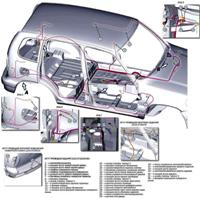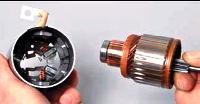The vehicle is equipped with heater 12 (Fig. 1) of liquid type, combined with the engine cooling system. The heater radiator 1 (Fig. 2) is placed in a plastic casing installed in the central part of the instrument panel
The vehicle can be equipped with either HVAC or HVAC.
These systems are designed to provide the most comfortable conditions for the driver and passengers, regardless of weather conditions.
The heating and ventilation system includes an outdoor air filter, a heater, a heater fan, air ducts and deflectors.
Through air ducts, air from the heater is supplied to the windshield and side window vents, to the central and side vents on the instrument panel, to the ventilation openings in the heater housing to supply air to the driver's and passengers' feet, and also to the rear seat passengers' feet.
The heating and ventilation system is controlled by turning the handles of the control unit, which is installed on the center console of the instrument panel.
The heater housing is installed in the center under the instrument panel, the heater fan housing is located on the right near the front pillar behind the glove box.
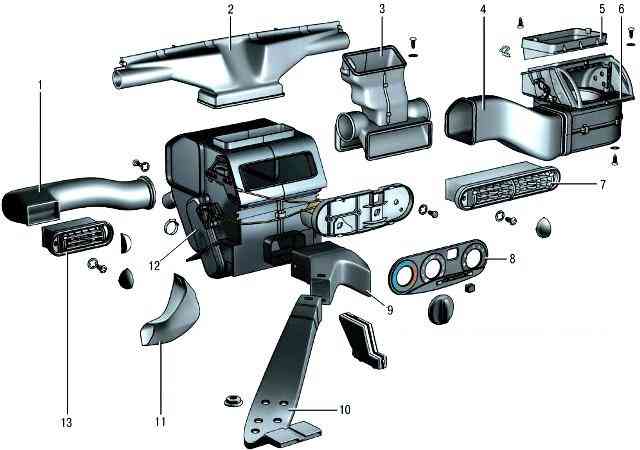
The heating system is liquid, combined with the engine cooling system.
The heater radiator is installed in the instrument panel console in a plastic casing and sealed around the perimeter with foam tape. Air heating depends on the degree of opening of the valve that regulates the flow of fluid through the radiator.
The valve is installed at the radiator inlet and is controlled by the upper lever on the center console.
The fan and the heater are interconnected by intermediate air ducts.
Outside air for interior ventilation when the car is moving enters the car through the air intake slots under the windshield and the outside air filter (cabin filter).
To improve air circulation in the passenger compartment, when driving, you can lower the door windows, and at low speed, turn on the heater fan.
In this case, turn the temperature control knob to the cold (blue) zone when outside air enters the passenger compartment, bypassing the heater core.
The air flows in the cabin are distributed by air ducts, which are located under the instrument panel and under the lining of the floor tunnel, and under the floor upholstery to supply air to the legs of the rear passengers.
The air distribution control knob on the center console of the instrument panel, as well as the controls and guides of the central and side vents on the instrument panel, serve to control the distribution of air flows.
To heat the interior, turn the temperature control knob to the hot (red) zone.
In this case, outside air is directed through a damper through the heater core, which is integrated with the engine cooling system.
The heater radiator is installed in a suitable housing and sealed around the perimeter with foam tape.
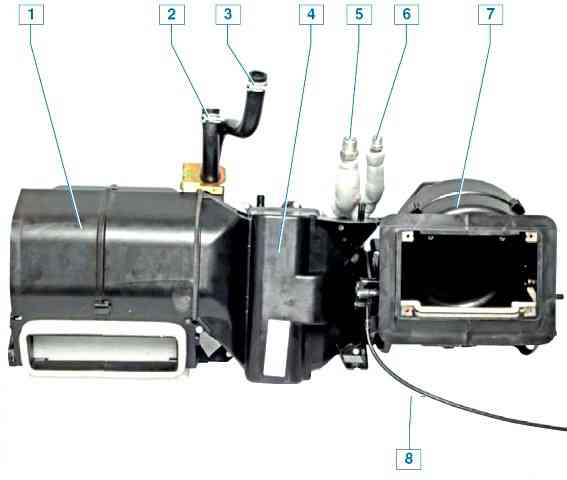
The electric motor of the ME-255 fan is a collector, direct current, with excitation from permanent magnets. The fan speed is controlled by a three-position switch on the instrument panel.
Depending on the selected speed, the electric motor is connected to the vehicle's on-board network directly (high frequency) or through an additional resistor (low frequency).
The frequency of rotation of the motor shaft with an impeller at a voltage of 12 V and an air temperature of 25 ± 10 ° C is 3000 ± 150 min -1. Current consumption at maximum speed - no more than 4.5 A.
The fan impeller is mounted on the motor shaft. electric motor The maker cannot be repaired if it fails, it is replaced.
The air is heated by the heat of the engine coolant circulating through the tubes of the heater radiator.
By turning the temperature control knob, you can change the position of the guide flap, thus adjusting the amount of air passing through the heater core.
The air temperature control knob is located on the center console of the instrument panel.
The intensity of the air supply is determined not only by the degree of opening of the external air damper, but also by the speed of rotation of the fan impeller, which is changed by turning the fan speed control knob.
The speed control knob is located on the center console of the instrument panel.
The fan motor can operate at four different speeds.
The direction of air flow through the cabin is carried out by the air flow distribution handle, which is connected with the dampers by rods.
By controlling the dampers, it is possible to direct air flows through the air ducts to the central and side vents on the instrument panel, to the lower ventilation openings in the heater casing, as well as to the glass grilles located in the instrument panel.
Some cars are additionally equipped with an air conditioning system, which is designed to reduce the temperature and humidity in the cabin.
The air conditioning system is turned on by pressing the air conditioner switch button located on the instrument panel, and the warning light located in the switch button lights up.
Before turning on the air conditioning system, it is imperative to turn on the heater fan and move the temperature control knob to the left, to the blue sector
Most of the air conditioning system components are located in the engine compartment.
In the passenger compartment there is only an evaporator located under the instrument panel in place of intermediate air ducts between the heater and its fan.
The evaporator serves to exchange heat between the air entering the passenger compartment and the refrigerant circulating in the air conditioning system.
As you move through the evaporator tubes, the refrigerant turns into vapor.
The process proceeds with the absorption of heat, the evaporator fins are cooled, the cold is removed from the fins and sent to the cabin with the help of the heater fan, helping to lower the internal temperature in the cabin.
The low pressure refrigerant in the gaseous state flows from the evaporator to the compressor, which pressurizes the refrigerant.
The air conditioning compressor is located on the right side of the engine block, below the engine cooling pump.
The compressor is driven by a V-ribbed belt from the accessory drive pulley.
An electromagnetic clutch is built into the compressor pulley, which turns the compressor shaft on and off from the pulley according to signals from the engine management system controller.
Refrigerant vapor from the compressor enters under high pressure into a condenser located in front of the radiator of the engine cooling system.
Passing through the cells of the condenser, the refrigerant is cooled by the oncoming air flow and with the help of cooling system fans. In this case, the refrigerant passes from a gaseous state to a liquid state.
Next, high-pressure liquid refrigerant enters the receiver, which is fixed under the right headlight in the cavity formed by the right fender, mudguard, front bumper and right bumper mudguard.
The receiver simultaneously performs several functions: as a filter, it cleans the refrigerant from impurities that have got into it; as a dehumidifier, it absorbs moisture that condenses inside the air conditioning system, and also serves as a reservoir for refrigerant.
From the receiver, the refrigerant enters the reducer located directly on the evaporator.
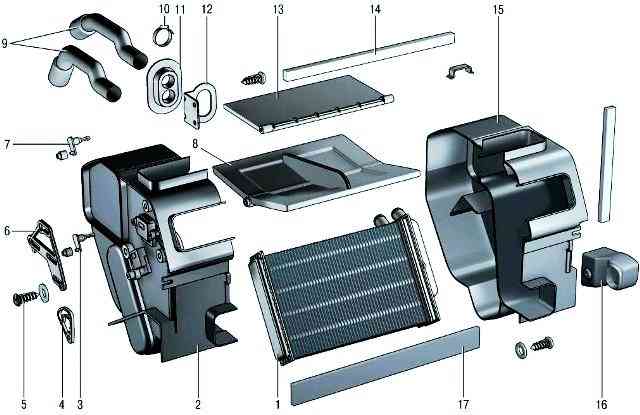
The reducer is a throttle valve, at the outlet of which the pressure and temperature of the refrigerant decrease sharply, as a result of which the refrigerant passes from a liquid state to a gaseous state.
In this form, the refrigerant passes through the evaporator again, cooling the air entering the car interior.
From evaporator the refrigerant is sucked in again by the compressor and the work cycle is repeated.
Valves are installed on the high and low pressure pipelines for charging and discharging refrigerant from the air conditioning system.
A refrigerant pressure sensor is installed on the high pressure pipe.
The pressure sensor sends a signal to the controller, which controls the electric fans of the engine cooling system, depending on the refrigerant pressure and vehicle speed.
In addition, according to the pressure sensor signals, the controller turns off the air conditioning compressor if the refrigerant pressure in the system is too low or too high.
A shut-off valve is installed in the fitting under the pressure sensor, which closes when the sensor is unscrewed, so there will be no refrigerant leakage from the air conditioning system when the pressure sensor is replaced.
The refrigerant in the air conditioning system is mostly under high pressure.
During work related to depressurization of the air conditioning system, avoid contact with eyes, skin and respiratory tract.
Any work with refrigerant should be carried out only in a ventilated area.
When charging the air conditioning system, use only materials recommended by the manufacturer.
It is forbidden to carry out welding or soldering work on the components of the air conditioning system.
Repair and maintenance of the air conditioning system should be carried out at specialized services.
Special equipment is used to search for leaks in the system, and a special contrast agent must be injected into the system.
After removing the refrigerant from the system, it is imperative to evacuate the air to remove residual moisture.
Before filling the air conditioning system, it is necessary to add special oil recommended by the manufacturer.









